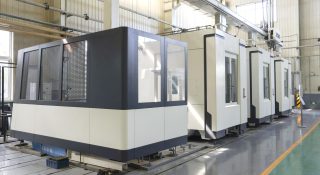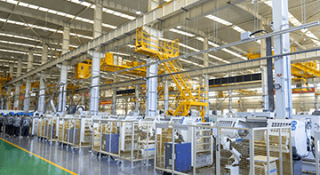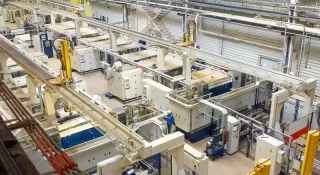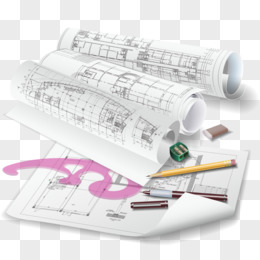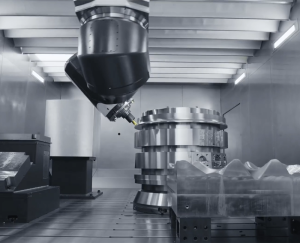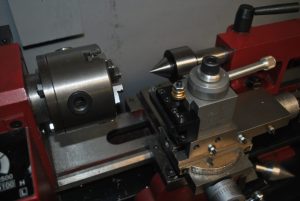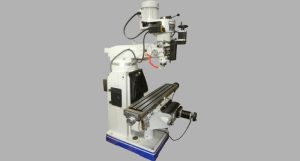Grinding machines are essential in modern manufacturing. They improve the precision and efficiency of workpiece processing and drive technological progress in various industries. Whether in metalworking, automotive manufacturing, or precision component fabrication, grinding machines are indispensable. In this article, we’ll explore several common types of grinding machines and their applications, giving you a glimpse into the fascinating world of grinding technology.
Grinding machines come in various types to meet different industrial needs. The main types include surface grinders, cylindrical grinders, centerless grinders, and tool and cutter grinders. Each type has a specific function, such as producing smooth surfaces, precise cylindrical shapes, or sharpening cutting tools.
Let’s dive into the grinding technologies that drive industrial progress, exploring their processes and practical applications.
Types of Grinding Machines
1. Cylindrical grinder:
Precision machining equipment specializing in external cylindrical grinding, suitable for cylindrical workpieces of various diameters and lengths.
Working principle: The workpiece rotates while clamped at the center, and the grinding wheel grinds along the axis.
Features: High precision, suitable for mass production, used in automotive, aerospace, and precision mechanical manufacturing.
Price range: Medium to high-end, ranging from $1000 to $100000.
Applications: Precision grinding of automotive engine shafts, rolling bearings, and intricate components.
2. Surface Grinder:
Used for precision flat grinding, ensuring surface flatness and accuracy of workpieces.
Working principle: Workpiece held on a worktable, grinding wheel moves horizontally to grind the workpiece surface.
Features: High surface smoothness, stable precision, suitable for mold, template, and mechanical parts manufacturing.
Price range: Mid to high-end, ranging from $100 to $10000.
Applications: Surface finishing of molds, precise grinding and finishing of flat parts.

3. Form Grinder:
Designed for grinding workpieces with complex shapes.
Working principle: Precise grinding according to preset profiles of the workpiece.
Features: Suitable for manufacturing complex shapes and high precision requirements, such as tools and precision mechanical parts.
Price range: Medium to high-end, ranging from $1000 to $100000.
Applications: Precision machining of complex parts, manufacturing and finishing of special-shaped components.
4. Jig grinder:
Designed for precise machining of workpieces securely fixed on jigs.
Working principle: Workpiece securely fixed on a jig, precise grinding using controlled grinding wheel.
Features: High precision, excellent repeatability, suitable for precise manufacturing of molds, templates, and specific parts.
Price range: Medium to high-end, ranging from $1000 to $100000.
Applications: Surface and internal machining of precision molds, manufacturing and finishing of high precision parts.
5. Hand Grinder:
Portable handheld tool used for simple rough grinding or polishing tasks.
Working principle: Operator manually holds and operates the grinding or polishing wheel.
Features: Flexible, portable, suitable for small parts repair and DIY projects.
Price range: Low to mid-range, ranging from $10 to $100.
Applications: Home repairs, light metalworking, and simple woodworking projects.
6. Thread Grinder:
Specifically designed for precision machining of various threads.
Working Principle: Uses precise control of the grinding wheel to grind threads on workpieces.
Features: High precision, good repeatability, suitable for engineering and manufacturing requiring precise threads.
Price Range: Medium to high-end, ranging from $1000 to $100000.
Applications: Machining threads for automotive engine components, mechanical threads, and precision instruments.
7. Centerless Grinder:
Grinder that does not require workpieces to be centered; supported by work rest and regulated wheel for grinding.
Working Principle: Workpiece supported by work rest, ground by regulating and grinding wheels.
Features: Efficient, suitable for long and slender workpieces like bearings and shafts.
Price Range: Mid-range, ranging from $1000 to $10000.
Applications: Automotive, aerospace, and engineering sectors for shaft-type parts machining.

8. Belt Grinder:
Uses belt abrasive for surface grinding and finishing.
Working Principle: Belt tool used for rough grinding, polishing, and finishing.
Features: Fast, efficient, suitable for large metal and wood surface treatments.
Price Range: Low to mid-range, ranging from $100 to $1000.
Applications: Metalworking, woodworking, and mold finishing.
9. Angle Grinder:
Handheld electric tool for metal cutting, grinding, and polishing.
Working Principle: Operator controls grinding wheel for tasks in construction, metalworking, and repairs.
Features: Flexible, multi-functional, used in building, metalworking, and DIY projects.
Price Range: Low to mid-range, ranging from $10 to $100.
Applications: Construction, workshop maintenance, and home DIY projects.
10. Double Column Surface Grinder:
For large workpieces’ surface grinding, with stable processing capability.
Working Principle: Workpiece held between double columns, grinding wheel moves horizontally.
Features: Used for large molds, mechanical parts’ surface processing requirements.
Price Range: Medium to high-end, ranging spend $10,000 or $100,000 on one..
Applications: Large molds, ship components, and aerospace parts machining and finishing.
11. Cryogenic Grinding Machine:
Uses low-temperature grinding technology for materials prone to melting or difficult to process.
Working Principle: Grinding at low temperatures to reduce heat effects and material deformations.
Features: Suitable for plastics, rubber, and powder metallurgy materials processing, maintaining material properties.
Price Range: Medium to high-end, ranging spend $10,000 or $100,000 on one..
Applications: Food processing, chemical, and pharmaceutical industries for fine grinding and powder handling.
12. Internal Grinder:
Grinder for machining internal holes of workpieces.
Working Principle: Grinding wheel enters the workpiece for precise internal grinding.
Features: High precision, suitable for small and deep hole machining, such as bearing holes.
Price Range: Medium to high-end, ranging spend $10,000 or $100,000 on one..
Applications: Automotive, aerospace, and precision mechanical shaft parts machining.

13. Universal Grinder:
Grinder capable of various types of grinding operations.
Working Principle: Suitable for external, internal, flat, and special-shaped workpiece grinding.
Features: Flexible, adaptable, meets various machining needs.
Price Range: Medium to high-end, ranging spend $10,000 or $100,000 on one..
Applications: General mechanical manufacturing, multi-functional parts machining and finishing.
14. Gear Grinder:
Specifically for precision machining of various gears.
Working Principle: Grinding gears with precise control to ensure accuracy and backlash.
Features: High precision, good stability, suitable for gears in automotive, aerospace, and engineering machinery.
Price Range: Medium to high-end, ranging spend $1,000 or $100,000 on one..
Applications: Transmission devices, mechanical transmission components, and precision instrument gear machining.
15. Bench Grinder:
A simple grinder that sits on a bench.
Working principle: You turn a wheel or flip a switch to turn the grinding wheel on and off to grind and finish things.
Features: It’s easy to use and good for grinding and fixing small pieces of metal and wood.
Price Range: They’re cheap. You can get one for $20 or $30, or you can spend a few hundred dollars.
Applications: In your home shop, in a school lab, or for light repair work.
16. Horizontal Spindle Grinder:
A grinder with a horizontal spindle for grinding big, flat things and shafts.
Working principle: The grinding wheel moves back and forth to grind the surface of the part and the shaft.
Features: It’s good for grinding big molds, ship parts, and big mechanical things.
Price Range: They’re expensive. You can spend $10,000 or $100,000 on one.
Applications: In the aerospace industry, in shipbuilding, and in heavy machinery manufacturing to grind big parts.
17. Precision Grinder:
A grinder that’s made to be really accurate.
Working principle: It uses a really accurate control for the grinding wheel to grind things to within a few millionths of an inch.
Features: It’s good for making things that are really, really accurate and have a really nice surface finish. It’s used in the optical, electronic, and medical device industries.
Price Range: They’re expensive. You can spend $10,000 or $100,000 on one.
Applications: To make really accurate optical parts, tiny mechanical parts, and medical devices.
18. Dry Grinder:
A way to grind without using coolant.
Working principle: You use abrasive tools to grind and finish things without using coolant. This saves money and is better for the environment.
Features: It saves energy and is good for grinding all kinds of metals and non-metallic materials.
Price Range: They’re cheap. You can get one for a few hundred dollars or a few thousand dollars.
Applications: To make molds and templates and to grind metal in general without using coolant.
19. Flexible Grinder:
A grinder that can do a lot of different things.
Working principle: You can use it in a lot of different ways to do a lot of different things to a lot of different parts.
Features: It’s good for doing a lot of different things to a lot of different parts in a lot of different kinds of production environments.
Price Range: It costs a lot. You can spend $10,000 or $100,000 on one.
Applications: In the automotive industry, in aerospace, and in general machine shops to do a lot of different things to a lot of different parts.
20. Tool Grinder:
A grinder for making and fixing tools.
Working principle: You use a really accurate control for the tools to grind and regrind them.
Features: It keeps your tools accurate and makes them last longer. It’s used to make and fix tools for machine tools, molds, and woodworking.
Price Range: They’re expensive. You can spend $10,000 or $20,000 on one.
Applications: To make and fix tools for machine tools, to make and fix punch dies, and to make and fix cutting tools.

21. Center Grinder:
A grinder for making centers.
Working principle: It grinds and trims centers to make sure your parts are in the right place and that they’re good quality.
Features: It’s good for making centers for making tools and molds.
Price Range: They’re expensive. You can spend $10,000 or $100,000 on one.
Applications: To make and trim centers for molds and mechanical parts.
22. Plunge-Cut Grinder:
A grinder for grinding deep holes by plunging.
Working principle: You plunge the grinding wheel into the part to grind deep and accurate holes.
Features: It’s good for grinding deep and accurate holes in parts so that the inside and outside of the part are the right shape.
Price Range: They’re expensive. You can spend $10,000 or $100,000 on one.
Applications: To grind deep holes in molds and in engine parts for cars.
How to Choose a Grinding Machine
When choosing a grinding machine, it’s important to consider several key factors to ensure it meets your processing needs and long-term usage requirements. Here’s a detailed guide to help you make the right choice:
- Determine Your Processing Needs: Identify the type of processing tasks you need to perform and the precision requirements to select a suitable grinding machine.
- Choose the Type of Grinding Machine: Depending on your specific needs, choose between surface grinders, cylindrical grinders, or centerless grinders.
- Evaluate Precision and Repeatability: Assess the machine’s precision and its ability to maintain stability during extended operation to ensure you can produce consistent, high-quality parts.
- Consider Cost-Effectiveness: Evaluate the overall cost, including the purchase price, maintenance expenses, and energy efficiency, to get the best value for your investment.
- Look for Technical Support: Choose a supplier that offers comprehensive technical support and after-sales service to ensure you receive timely assistance and maintenance when you need it.
This article explores different types of grinding machines and their applications, providing valuable references for your selection. If you have any questions or need more information, please feel free to contact us.


